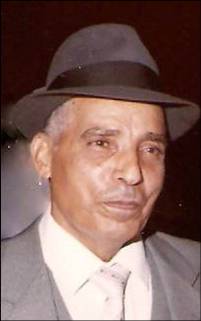
Yehuda Levi Nahum
Founder of the "Exposure of Yemen's Treasures" Project
and Collector of the "Nahum Collection of Yemenite Manuscripts"
Yehuda Levi Nahum was born in 1915 in San’a, the capital of Yemen. He was the son of Levi ben Sai’d Nahum and Badreh Manzali, and was the third of eight children.
Yehuda attended the Heder (school) as a child, as was the Jewish custom, but he was forced to discontinue his studies due to his family’s financial issues. He was not interested in the family’s butcher profession, so he learned to make various sweets and candy and sold them for profit. He also bought and sold haberdashery. He saved his money to pursue his childhood dream of living in Israel.
In 1929, when Yehuda was fourteen, his father realized that he could not prevent Yehuda from fulfilling his dream. With his mother’s support, he received his father’s blessing and was even given a donkey for his travels.
Yehuda made the two-week trip from San’a to Aden riding his donkey and accompanied by other Jewish families making the same journey. When he arrived in Aden, he sold the donkey to pay for a boat ticket to Port Said, Egypt; and then a train ticket to Jaffa, Palestine.
A few days after his arrival, Yehuda traveled to Jerusalem, the Holy City. By day he earned his living as a delivery boy; in the evenings he joined groups of students to study the Torah. Due to economic difficulties in Jerusalem at the time, he was forced to move to Tel Aviv to look for work. Once in Tel Aviv, he learned the butcher trade and became a menaker.
In 1938, Yehuda married Naomi Yemini, whose silversmith family had arrived from Yemen in 1896. Together they had three children: Ahuva, Achiassaf and Talia.
When the War of Independence erupted in 1948, Yehuda was drafted to the army and received the War of Independence medal for his excellent service. In 1949, his family arrived from Yemen through Operation Magic Carpet.
After surviving a difficult illness, Yehuda vowed to dedicate his life to commemorate the heritage of the Yemenite Jews. In 1942, he established the “Mif’al Lehasifat Ginzei Teiman”, the Project of Unveiling Yemenite Manuscripts. The primary purpose of the project was to bring to light the written treasures of the Yemenite Jews and avail them to the public; he also strove to refute erroneous views amongst the Israeli public about the Yemenite Jews. In support of the project, he asked his parents to send him hand-written books from Yemen; some of which arrived safely, some were stolen, and some were lost en route. When the Yemenite Jews were brought to Palestine, Yehuda traveled to the newcomers’ camps and settlements to collect and buy as many old books and manuscripts as he could.
Yehuda’s crowning achievement was discovering what was hidden within the covers of the Yemenite books. According to Jewish tradition, old books and manuscripts were saved and made into covers for new books rather than thrown away. He devised a method to disassemble the covers and discovered thousands of ancient single pages. He called these findings “The Wandering Treasures.”
In addition to collecting these materials, Yehuda researched the documents he found and collaborated with academic researchers in Israel and abroad. His lifetime of research and certain important manuscripts are documented in the nine books he published on his own.
Yehuda Levi Nahum established a permanent exhibition of his findings in his house in Holon, Israel. Among the numerous visitors to his exhibition were two Israeli Presidents: Izhak Ben Zvi, who visited in 1952, and Zalman Shazar, who visited in 1968.
Yuda, as he called himself, passed away on August 12, 1998.
The photographed collection you will find here is evidence of Yehuda’s lifelong dedication to his work, a commitment spanning sixty years. Some of his collection has been researched and published; the rest is waiting to be discovered and further researched. Anyone willing to do this work will be blessed.
